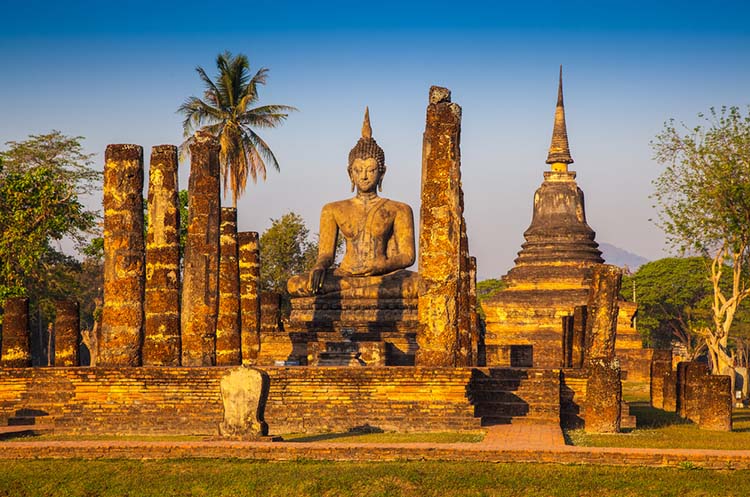
Temples
In Sukhothai Historical Park
Sukhothai Historical Park contains the remains of dozens of temples, many of which are well preserved. The park covers an area of 70 square kilometers, in which nearly 200 ancient monuments from several eras remain.
Excavation and restoration works have been performed by the Thai Fine Arts Department. Valuable artifacts and Buddha images discovered during the works are exhibited in the Ramkhamhaeng National Museum.
Zones of the Historical Park
The ruins are spread out across five zones. The central zone contained within the old city walls contains the best known monuments including the Wat Mahathat, the largest and most important temple of the Sukhothai Kingdom.
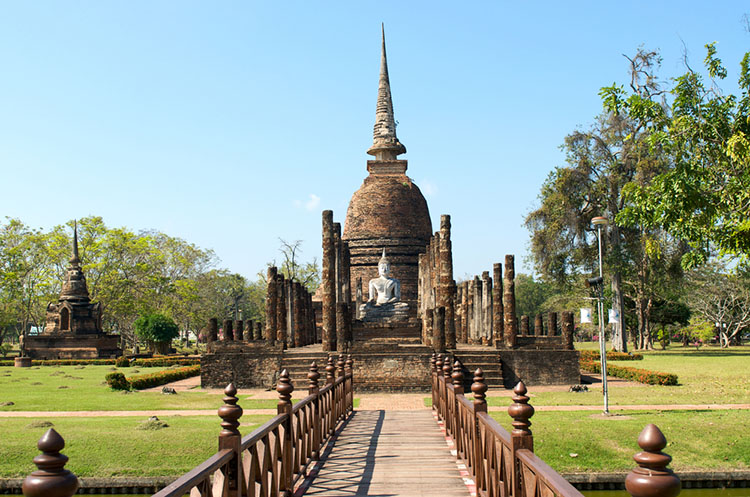
Wat Sa Si
Outside the city walls in the North, East, South and West zone are well over a hundred monuments in various states of preservation. The smaller temples consist merely of the base of a single viharn or the remains of a chedi. North of old Sukhothai are a few sites where kilns have been excavated where the Sangkhalok wares were made.
The Sukhothai Historical Park contains examples of styles from various periods, including Khmer, Sukhothai, Singhalese, Ayutthaya and Mon Hariphunchai.
Sukhothai style
Sukhothai developed its own style, mainly influenced by Singhalese architecture. Examples of the Sukhothai style include images of the walking Buddha, the large standing images known as Phra Attharot, the lotus bud chedi, the elephant encircled chedis and the four images of the Buddha in different postures enshrined in a mondop.
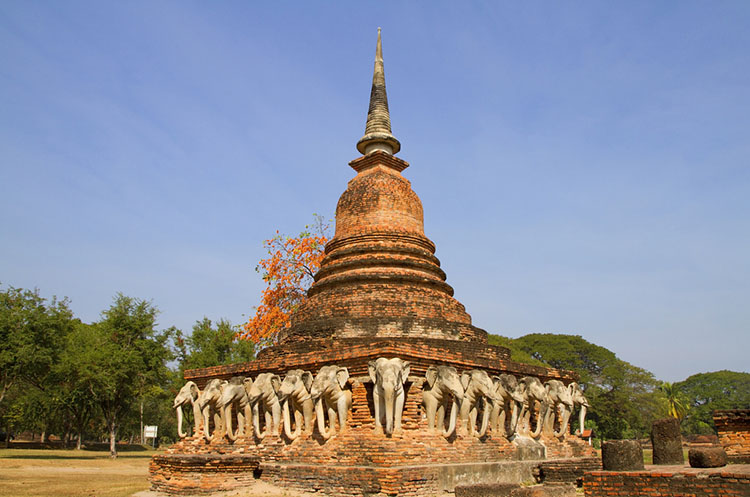
Wat Sorasak
Walking Buddha
Probably the best known example of the Sukhothai style is the images of the walking Buddha. The very graceful images portray the Buddha in a walking posture, the clothing draped loosely around the body, the heel of one foot lifted. The image depicts the Buddha’s descend from the Tavatimsa Heaven where the Buddha taught the Buddhist teachings to His mother. Images of the walking Buddha can be seen at the Wat Sa Si and the Wat Tra Phang Ngoen, both in the central zone.
Phra Attharot standing Buddha images
Large images of the Buddha were popular during the Sukhothai era. The 12 meter high standing images of the Buddha known as Phra Attharot can be found at the Wat Mahathat and the Wat Saphan Hin in Sukhothai.
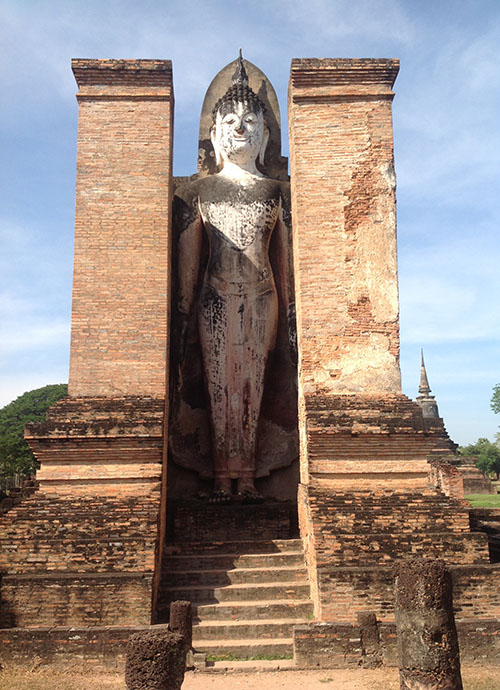
Wat Mahathat
Lotus bud chedi
The lotus bud chedi, known as Phum Kao Bin, is unique to the Sukhothai era. The chedi stands on a high square base of several receding tiers and is topped with a finial in the shape of a lotus bud. Lotus bud chedis, usually the main chedi of the temple, are found in Sukhothai, Si Satchanalai and Kamphaeng Phet Historical Parks. Both the Wat Mahathat in Sukhothai and the Wat Chedi Chet Thaeo in Si Satchanalai have several lotus bud chedis.
In Buddhism the lotus flower symbolizes purity and divine birth. Although the new flower is born and grown in mud, the unopened flower is like the heart of all living beings; the flower opens and blossoms when the virtues of Buddhism develop in there by following the teachings of the Buddha.
Buddha images in four postures enshrined in a mondop
Another example of Sukhothai style is the mondop or mandapa enshrining four large images of the Buddha in four different postures, namely standing, walking, sitting and reclining, each facing a different direction. Mondops in this style can be found at the Wat Chetuphon and the Wat Phra Phai Luang in Sukhothai.
Elephant encircled chedis
Several elephant encircled chedis were built during the Sukhothai era. The chedi stands on a square base, out of which the statues of elephants protrude that appear to carry the chedi on their backs. Elephants are a symbol of mental strength in Buddhism and act as guardians protecting temples. Elephant encircled chedis in Sukhothai are the Wat Sorasak in the central zone and the Wat Chang Lom in the East zone.
Khmer style
The oldest monuments in the Historical Park pre dating the Sukhothai era were built by the Khmer, during a time when the area was an outpost of the Khmer empire from Angkor. The best examples of Khmer style architecture are the three well preserved prangs of the Wat Si Sawai in the central zone and the single remaining prang of the Wat Phra Phai Luang in the North zone.
The temples were built as Hindu shrines dedicated to Shiva, as can be seen from the linga base of the Wat Phra Phai Luang. The linga base used to support the linga, the representation of Shiva. The prangs are adorned with stuccoed Brahman depictions often found on the temples of Angkor. Khmer temples were converted into Buddhist monuments during the Sukhothai era.
Another Khmer structure is the Ta Pha Daeng Shrine, located in the central zone.
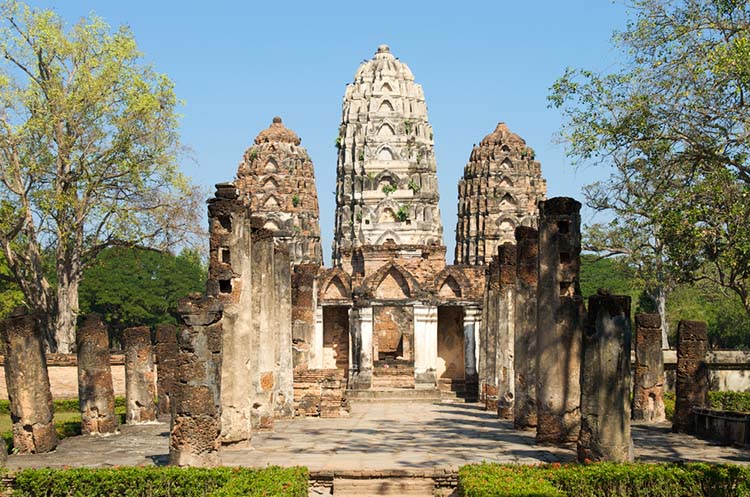
Wat Si Sawai
Mon Hariphunchai and Ayutthaya style
A few examples of Mon Hariphunchai architecture can be found in the Sukhothai Historical Park. The best known one is the four chedis surrounding the principal chedi of the Wat Mahathat, that resemble the Mahabol chedi of the Wat Ku Kut in Lamphun. After Sukhothai had lost its influence and had been annexed by the Ayutthaya Kingdom, Ayutthaya style structures were added in many of Sukhothai’s temples. Several Ayutthaya era viharns can be found at the Wat Mahathat in the central zone.
Temples in the Sukhothai Historical Park
Some of the temples are:
- Private or group tour
- Full day tour from Sukhothai
- Explore historical park & countryside by bike
From Chiang Mai
- Private or group tour
- One day or multiple days tour from Chiang Mai
- Explore historical park & countryside by bike